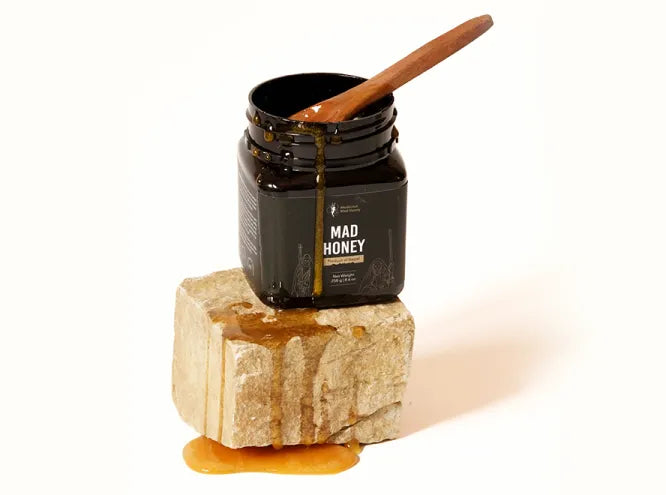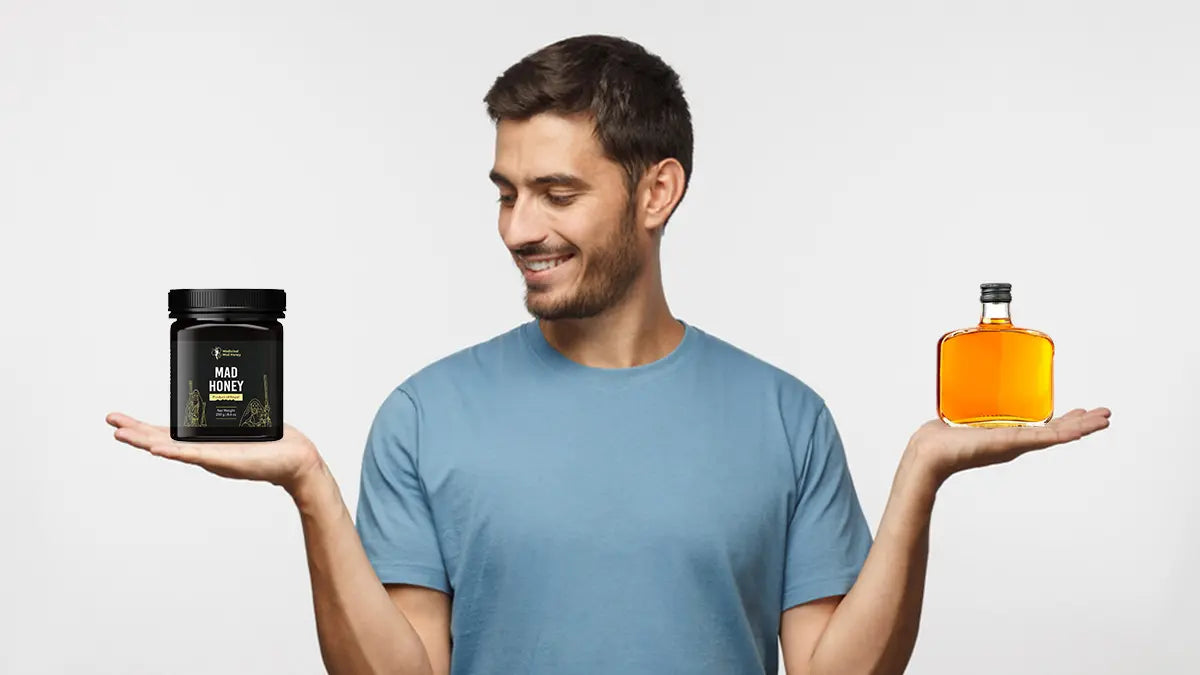Alcohol can be the best beverage whether you are dealing with stress or trying to enjoy an event as it can induce feelings of joy and relaxation. It is not recommended by health experts and researchers but some still find a way to enjoy this substance. It is an depressant which depresses central nervous system that can lower inhibitions and make social situation more fun.
Although the experience is Euphoric and leads to stress release, it can bring in unpleasant experiences after several hours. These unpleasant experiences involve symptoms such as fatigue, weakness, thirst, headache and increased blood pressure. This unpleasant experience is widely known as “Hangover” and has a combination of factors involving dehydration, changes in immune system and disturbance in Glucose metabolism. Besides alcohol there are several substance for intoxication, relaxation and a sense of euphoria, among them a legal potent natural elixir known as mad honey is drawing people's attention in recent times. Even Joe Regan had experienced Mad Honey during one of his podcast.
Understanding Mad Honey
Rhododendron nectar collected, processed and stored by Himalayan Giant bees known scientificially as Apis Laboriosa is famous around the globe which is harvested and sold under the name of Hallucinogenic Honey. The Grayanotoxin present in the nectar continues along the honey and shows effects which are somewhat hallucinogenic and maddening if taken in overdoses. If ingested honey is within dosage guidelines the effects can give in feelings of ecstasy and a sense of relaxation. Based on the effects it is also popular for the name of Mad Honey, Psychedelic honey, Intoxicating honey, Wild Cliff Honey and several other names. Black Sea Region of Turkey, high cliffs of Nepal and some other places are famous for this type of Honey with ancient cultural practices and uses.

Understanding Alcohol
People throughout the world have been using ethanolic alcohol as their most common psychoactive substance since ancient times. The CNS-depressive property of alcohol appears in beverages such as beer, wine and spirits which create relaxation and reduced inhibitions combined with perceptual changes in users. Socially acceptable portions of alcohol consumption present acceptable benefits to users along with traditional use in social settings. Too much alcohol intake creates two severe consequences: addiction and liver disease combined with cognitive impairment and multiple physical and psychological problems. Most areas of the world enforce legal regulations regarding alcohol but it remains different from mad honey because of its legality.
Learn age wise consumption guide of Mad Honey for different age groups.
Key Differences Between Effects of Mad Honey and Alcohol
- Chemical Composition: Mad honey differs chemically from alcohol at its core because of the toxic elements found in mad honey. Grayanotoxins present in mad honey target body sodium channels which can create several impacts in the human body including slow down of the heart. The sedative properties of alcohol stem from its ability to increase GABA activity and block glutamate neurotransmitters in the central nervous system as a depressant substance. It typically slows down the functioning of the brain and body. The effects they deliver from these compounds are somewhat similar to each other.
- Effects: The psychoactive impact of these substances stands apart from each other although they have activating properties that interact with the mind. The consumption of Mad Honey on higher doses leads to strong hallucinogenic reactions. Users can experience visual and auditory hallucinations together with modifications of their sense of time and space as well as profound feelings of elation or intense reflection. Consuming alcohol causes a well-predictable sequence of inebriation that affects people based on their alcohol consumption levels.
- Intoxication Duration: Alcohol results in effects which start rapidly within 5 minutes of consumption after it reaches the brain and last for a limited period of a few hours. Intoxication levels from this substance depend on its consumption speed because it can grow stronger or fade based on how fast it gets into the body. The delayed start time of Himalayan cliff honey consumption results in very long-lasting effects across multiple hours to few days depending on the dosage levels and tolerance of each individual person.
- Overdose: Intake of large doses of mad honey put consumers at higher risk of toxicity because grayanotoxins found in the substance possess lethal side effects. Alcohol overdose occurs with binge drinking but alcohol normally stays harmless at average consumption levels. The difference between a harmless and unsafe dose of mad honey exists in very narrow and dangerous limits when consumed.

Safety and Health Considerations
The misuse of both substances creates specific dangers to health. Excessive alcohol use results in alcohol poisoning as well as liver damage whereas it also leads to addiction. Long-term alcohol use causes multiple serious health problems that affect cardiac health, produce cancers and trigger mental illness disorders. The recreational use of mad honey on higher doses proves toxic to the human body and can result in vomiting and abnormal heart function with death in extreme cases. The intoxicating effects of mad honey can be lethal and can last for hours or even days based on the volume taken.
Health concerns stem from addictions when using alcohol as well as other harmful effects linked to alcohol consumption. Medical experts classify Alcohol use disorder (AUD) as a certified medical condition which ranks among the most common substance addiction problems across the world. Abuse of mad honey produces health complications yet remains unlikely to trigger physical dependence because of its rare availability when compared to alcohol. Also, it is equally important to identify fake honey from real ones as the fake honey can have adverse effects on human health.
Traditional and Recreational Uses
Traditions of using mad honey as treatment extend over ages in the areas where it undergoes local harvesting from high cliffs using traditional tools. The Gurungs and Kulungs are well known as the honey hunters of the Himalayas and they have been practicing the process of mad honey harvesting since a long ago. The skill and knowledge has been transferred from one generation to another and the process is cultural and traditional.
These ethnic groups of Nepal have developed a strong connection with the Himalayas and the Mad Honey. They have been using it as a wellness product to treat several alignments regarding Gastrointestinal, Arthritis, Abdominal Pain, Ulcers, Honey Cough remedies, Aphrodisiac, Antiseptic and pain reliever. Some people have also been found to use this mad honey for experiencing spiritual awakenings, moment of clarity and mindfulness.
Tradition of alcohol intake also stems around different cultural and ethnic groups. Alcohol plays significant role in the rituals. festivals and religious ceremonies where alcohol and other food ingredients are offered to deities of the certain religions. The consumption of alcohol is deeply rooted in the cultural background where the locally made alcohol is shared among the groups of people. It enhances social bonding while makes the social environment enjoyable and creates a moment of happiness.
Despite the recreational applications of mad honey in modern world, mad honey mostly serves as a substance with medicinal and therapeutic purposes whereas alcohol primarily supports recreational and relaxation activities. This is the dividing line separating the consumption for health and sense of Euphoria.
Legal Status and Availability
The global regulatory system distinguishes between legal status for mad honey versus alcohol consumption. Alcohol falls under the category of depressant drug which slows down the central nervous system and decreases brain activity. Meanwhile Mad Honey is a type of honey which is little different that the normal honey except it contains natural neurotoxin called Grayanotoxin within it.
The FDA has not classified it as a substance neither has specific documents or statements regarding mad honey. But they routinely assesses imported honey products to ensure accurate labeling and prevent consumers from being deceived. So Mad Honey is a type of Wild Honey harvested form the high cliffs and has medicinal properties when taken in moderate dosage. This is the reason why wellness enthusiasts and alternative medicinal practitioners from west are showing growing interest towards Mad Honey.
Although FDA does not regulate all types of alcohol there are certain alcohol types that are forever banned for sale and use. While those regulated for consumption by licensing laws exists alongside countrywide have age restrictions. The age restriction for alcohol purchase and consumption does apply in most nations that permit alcohol. There are several laws that has been implemented for alcohol users for example the drunk man is not allowed to drive, not operate any sort of commercial vehicles. Even it is illegal to appear drunk in the public places.
Understanding the adverse effects of Alcohol, there are strict laws and regulations made and implemented to minimize potential risks. But Mad Honey too is not fully legal around the globe. Countries like Brazil, South Korea, Australia has banned the use and sale of mad honey so as to protect the consumer from potential health risks. The legal availability of mad honey exists only in specific regions that sell it from specialized retailers based in rural areas and through particular online platforms. One must check the legal status of Mad Honey before buying or trying it.
Choosing the Best Option
So, how do you normally choose what you are taking for relaxation and the feeling of euphoria? Do you usually buy and get something that is readily available (Alcohol) or do you seek something that is unique for you?
Analysis requires one to evaluate effects of mad honey in comparison with alcohol while considering possible impacts on safety together with personal health aspects. People who need a well-defined recreational interaction alongside a manageable experience should use alcohol as it presents less risk than mad honey does. Intake of alcohol should remain responsible with awareness about potential consequences such as addiction and overdose. The overdose effects of mad honey exceeds ordinary psychoactive experiences but users must be aware of its powerful effects when using it.
These substances deliver surreal experiences through unique mechanisms although their safety conditions and health results differ substantially. Before making a choice, an individual must carefully consider their intended results together with their natural resistance to different substances and the potential safety issues surrounding each product. The availability of Mad Honey, hard local harvesting methods and rarity directly influences high price of mad honey meanwhile alcohol can be a better option at cheaper terms.
Buy Mad Honey Nepal from the top trusted brand of Medicinal Mad Honey – Order now for premium quality and authentic benefits!
Conclusion
Mad honey and alcohol represent separate substances which generate different sequences of physical responses through their effect on body and mind. People widely accept alcohol but the unique experience of mad honey presents significant health threats because of its strong unpredictable effects. Users may enjoy these substances safely provided that safety becomes their primary concern. People can determine suitable substances by knowing fundamental distinctions and health risks along with legal consequences contained in these substances.
FAQs
Q: How much mad honey should I take?
A: It's recommended to start with a small amount (around 1-2 teaspoons) to assess your tolerance. Higher doses should be avoided without proper guidance from a healthcare professional.
Q: How to take mad honey?
A: Mad honey can be consumed directly, or mixed into warm water, tea, or food. Start with a small amount to understand how your body reacts.
Q: How to get mad honey?
A: Mad honey is typically sourced from regions like Nepal and certain parts of Turkey. It can be purchased from specialized online retailers or local suppliers.
Q: How long does mad honey stay in your system?
A: Mad honey stays in your system for several hours, typically around 6-8 hours, depending on the amount ingested and individual metabolism.
Q: What's the difference between honey and mad honey?
A: Regular honey is made from nectar of various flowers, while mad honey comes specifically from rhododendron flowers containing grayanotoxins. These compounds cause hallucinogenic and medicinal effects.
Q: What are the effects of mad honey?
A: Mad honey can cause dizziness, nausea, low blood pressure, hallucinations, and in small doses, relaxation or mild euphoria. High doses may be toxic.
Q: Does mad honey taste different?
A: Yes. Mad honey has a slightly bitter, earthy taste compared to the sweetness of regular honey. Its unique flavor hints at its toxic compounds.
Q: Can mad honey be used medicinally?
A: In small doses, mad honey has been traditionally used for hypertension, diabetes, and sexual stamina. However, improper use can be dangerous.
Q: Does mad honey lower your blood pressure?
A: Yes, Grayanotoxins in mad honey slow the heart rate and dilate blood vessels, lowering blood pressure. Overuse can cause severe hypotension.
Q: Why is mad honey so expensive?
A: It’s rare, harvested only in limited high-altitude regions, and difficult to collect. Its medicinal and psychoactive properties further increase demand.
Q: Does mad honey get you drunk?
A: Not in the alcoholic sense. Mad honey intoxication feels like dizziness, warmth, hallucinations, or euphoria due to neurotoxic compounds.
Q: Can you legally buy mad honey?
A: Yes, in most countries it’s legal as a natural product, but regulated in some regions due to health risks.
Q: Is manuka honey mad honey?
A: No, Manuka honey is from New Zealand’s manuka bush and valued for antibacterial properties. Mad honey comes from rhododendrons and contains toxins.






